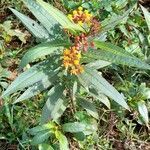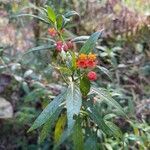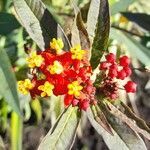Erect shrub to 1.5 m high. Leaves with petiole 3–20 mm long; lamina lanceolate-ovate, to 15 cm long, to 3 cm wide, attenuate to cuneate at base, acute; secondary veins 10–12 each side of midrib; colleters absent. Inflorescence umbelliform. Flowers c. 1 cm long, 1.5 cm diam.; pedicels 12–18 mm long. Corolla lobes reflexed, lanceolate, 8–8.5 mm long, 3.5–4 mm wide, orange-red. Staminal corona c. 4 mm long, yellow; lobes c. 3.5 mm long, 1.5 mm wide. Follicles fusiform, 5–6 cm long, 8–10 mm diam.
puberulent. Flowers with the calyx green, hidden by the reflexed petals in the mature flower, 5-lobed, the lobes 2-3 mm long and 0.8-1 mm wide; corolla red to orange-red, lobes ovate to oblong, 4-7 mm long and 2-3 mm wide; corona segments erect, broadly ovate, 4-5 mm long, rounded or obtuse at the apex, exceeded by the conspicuous inner horns, bright yellow. Follicles erect, fusiform, slender, 8-10 cm long, 1-1.5 cm in diameter; seeds ca. 6 mm long, narrowly winged, with a white, silky coma.
Erect herb, 60-80 (-200) cm high, mostly simple-but sometimes multi-stemmed, green, glabrous or slightly pubescent on the younger parts. Leaves opposite, lanceolate to linear-lanceolate, attenuate-acuminate, basally acute or attenuate, 5-16 cm long and 1-4 cm wide; blades thin, glabrous or glabrate; petioles 1-2 cm long. Inflorescence few-flowered, axillary; pedicels 1-2 cm long,
An erect small shrub. It grows 60-90 cm high. The leaves are 13 cm long. They are narrowly oval and taper at both ends. The flowers are in clusters at the ends of branches. These are 5-10 cm across. They are orange and red. The fruit are spindle shaped pods.
Umbelliform inflorescences of flowers scarlet reflexed corolla-lobes and yellow corona.
An erect, shrubby herb up to 5 ft. high












